When planning construction on their site, many owners have to decide which is better, a house from a bar or a log. There is no definite answer here, since each material has its own characteristics, pros and cons, characteristic nuances of installation, operation, maintenance and overhaul.
Varieties of logs
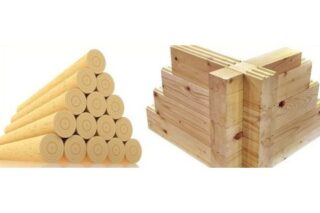
Despite the development of new technologies for the construction of residential buildings, their architecture and planning, the emergence of innovative building materials, log cabins do not lose their attractiveness and popularity.
The following types of logs are used in construction:
- Rounded. It is a trunk that undergoes precise processing on machines, during which part of the wood is removed from it, and then grinding and polishing is carried out. The result is products with precise geometric shapes. There are logs with completely rounded walls and their modifications with semicircular grooves. The diameter of the finished product is 15-25 cm with a length of up to 600 cm.
- Whole. The process of their production is not complicated, hence the lower cost. During the manufacturing process, only the bark is removed from the tree by hand or on a machine, and a layer impregnated with resin remains on the surface, which protects the log from dampness and insects. Installation from such material is of increased complexity, but the end result is worth it.
One of the varieties of wooden houses is a wild log house, assembled from wood of the most intricate shapes and sizes. This technology is very expensive and only a few companies worldwide are engaged in it.
Varieties of timber
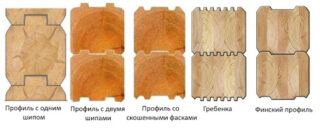
The timber is made of wooden profiles of square, rectangular and "D" -sections. It is obtained by cutting off the semicircular parts of the trunk until the parameters of a rectangular geometric figure are achieved. Products have a wide range of applications in monolithic and frame construction.
For the construction of private houses, the following types of profiles are used:
- Plain. It is an elongated rectangle made of solid wood with flat and even edges. Their processing can be carried out to a certain degree of smoothness or remain rough, with irregularities and protruding fibers. It is the most inexpensive product in this line of profiles.
- Profiled. A kind of massive timber, in which paired spikes and grooves are cut on the upper and lower edges. Thanks to this, the connection of the rims is carried out tightly and without gaps. Over time, as they dry out, the spikes go deeper into the grooves, which contributes to even greater tightness.
- Glued. An innovative option with increased strength, absolute resistance to cracking and deformation. Profiles are made from well-dried boards glued together under a press. Distinguish between profiled and smooth models. The former are used for laying out walls and ceilings, the latter are used for racks, supports and rafters.
The cost of production will vary significantly. Considering that houses are made for at least 50 years, it is better to spend money, but get high-quality, beautiful, comfortable and durable housing.
Comparative characteristics of materials
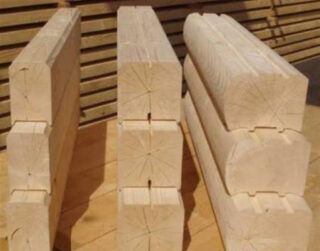
In the private sector, logs and beams for the home are used everywhere. The choice in relation to a particular technology is made based on the criteria that are prioritized for themselves. The main characteristics of each material should be examined and compared.
They are summarized in the table:
| Indicator | Log | Beams |
| Manufacturability | Average | High |
| Thermal insulation | Low | High |
| Biological resistance | Average | Average |
| Hygroscopicity | High | Average |
| Strength | Low | Average |
| Ecological cleanliness | High | Average |
| Durability | Average | High |
| Presentability | High | Average |
| Construction speed | Average | High |
Modifications of laminated veneer lumber are considered the most expensive, then there is a log with grooves, massive timber and logs without polishing close the price range.
Features of materials
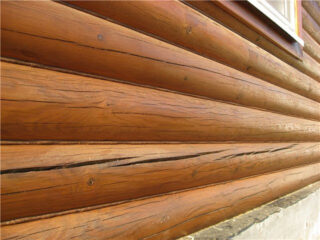
Wood has the following characteristics:
- pleasant to look at the surface;
- presentability, creating a sense of luxury and patriarchy;
- low thermal conductivity;
- hygroscopicity;
- tendency to dry out;
- susceptibility to decay, fungus and mold;
- loss of color and strength under the influence of ultraviolet radiation;
- high fire hazard;
- susceptibility of massive lamellas to cracks.
Wood has rather contradictory properties, but part of the negative list can be significantly reduced or reduced to a minimum.
Advantages and disadvantages of logs and beams
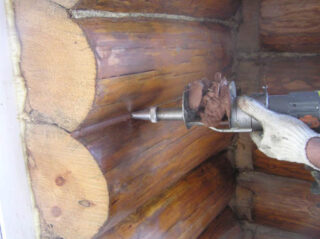
Advantages of buildings made of rounded logs:
- the facade does not need additional finishing, only sanitization;
- exact docking of the crowns with each other, no gaps;
- speed of construction of buildings;
- relatively affordable cost of the project;
- excellent thermal insulation due to high-quality fit of parts.
Disadvantages:
- high shrinkage rates of finished walls;
- tendency to cracking;
- restrictions on humidity during the construction of buildings;
- as the walls shrink, you need to constantly caulk;
- increased susceptibility to natural factors due to the embossed surface.
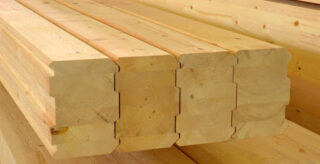
The advantages of timber buildings:
- fast styling, no need for adjustment;
- low cost;
- wide assortment and constant availability of material;
- tight joint and high strength for glued models;
- excellent thermal insulation due to uniform thickness over the entire area;
- reduced level of influence of natural factors.
Disadvantages:
- massive profiles shrink strongly, the formation of deep cracks is possible;
- there is a risk of deformation and distortions;
- external cladding is recommended;
- antiseptic and fire-fighting treatment is necessary;
- the presence of glue in puff products, which reduces their environmental friendliness.
Both materials have a lot of positive properties, but they are far from ideal. There are two main criteria - beauty and practicality.
Rules for choosing material for building a house
The choice of the type and grade of wood plays an important role. Some are more resistant to moisture, others to insects, and still others to shrinkage.

The craftsmen have at their disposal the following types of raw materials:
- Pine. It has a yellowish color with a striped texture, a pleasant smell, and is easy to process. The disadvantages are softness and a tendency to decay. The cost is the most loyal.
- Spruce. Homogeneous, almost white texture with consistent color. The massif is distinguished by its low weight, low thermal conductivity, and shape retention. In processing, wood is difficult due to its resinous viscosity.
- Cedar. For residential buildings, this is the best option. On the cut, the profiles have a beautiful pinkish tint, the density and thermal conductivity are unusually low, and the processing is easy. The presence of essential oils in the array prevents fungal and insect infestation of the material.
- Larch. Belongs to valuable breeds, has long been used in shipbuilding.Differs in high density, hardness and increased thermal insulation properties. In the private sector, it is more often used as lower crowns, more than others subject to the influence of dampness and mechanical factors.
Cedar and oak are rarely found on sale due to their high cost. The raw material is heavy, with high thermal conductivity. The strength of such buildings is extremely high, but they are cold and require additional insulation.
When buying wood, you need to pay attention to the correct geometry and type of product (1 or 2), its moisture content. It should be no higher than 21% for a log and 12% for a bar. Attention should be paid to appearance. The profiles should be free of cracks, dents and signs of rot.








